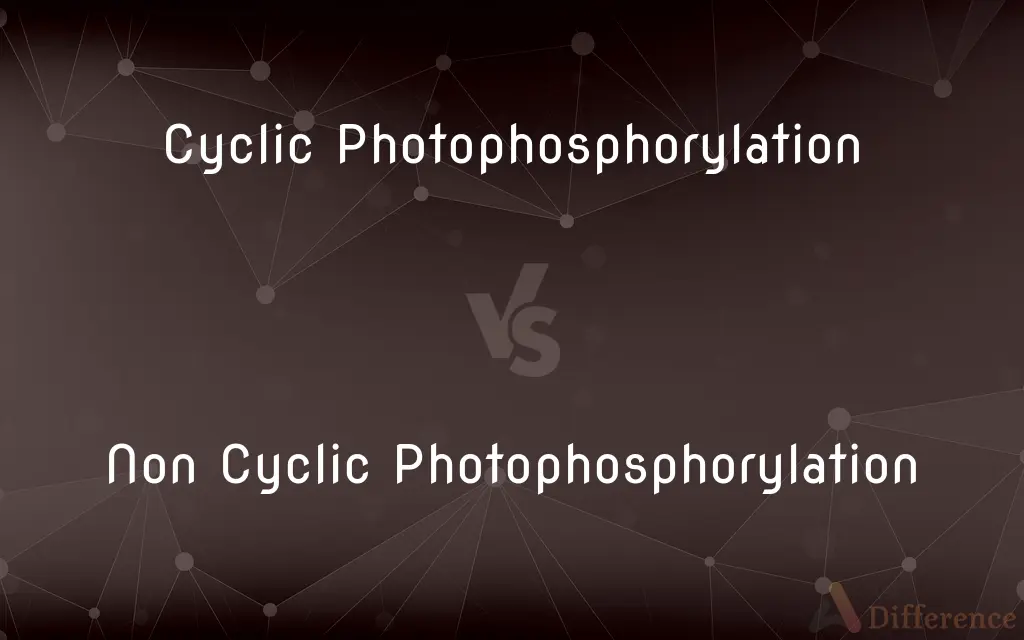Cyclic Photophosphorylation vs. Non Cyclic Photophosphorylation — What's the Difference?
Edited by Tayyaba Rehman — By Maham Liaqat — Published on May 10, 2024
Cyclic photophosphorylation involves electrons cycling back to the original chlorophyll, while non-cyclic photophosphorylation results in the reduction of NADP+ to NADPH.

Difference Between Cyclic Photophosphorylation and Non Cyclic Photophosphorylation
Table of Contents
ADVERTISEMENT
Key Differences
Cyclic photophosphorylation involves the flow of electrons in a circular path back to the photosystem, facilitating ATP production without the generation of NADPH or the release of oxygen. On the other hand, non-cyclic photophosphorylation involves electrons moving from water to NADP+, producing both ATP and NADPH, along with the evolution of oxygen as a byproduct.
In cyclic photophosphorylation, only photosystem I is involved, and the process primarily occurs under conditions of high NADPH concentration or when there is a need for ATP but not for NADPH. Whereas, non-cyclic photophosphorylation involves both photosystems I and II, operating under normal light conditions to produce the ATP and NADPH required for the Calvin cycle.
The electron source in cyclic photophosphorylation is the chlorophyll molecule itself, which gets replenished after the electrons complete their cycle. Conversely, in non-cyclic photophosphorylation, the electrons originate from water molecules, which are split in the process, releasing oxygen as a waste product.
Cyclic photophosphorylation does not contribute to the net production of NADPH, making it less effective in driving the synthesis of carbohydrates in the Calvin cycle compared to non-cyclic photophosphorylation, which produces both ATP and NADPH in stoichiometric amounts needed for carbon fixation.
The environmental conditions can influence the predominance of one pathway over the other. Cyclic photophosphorylation is more common under stress conditions or when the ATP/NADPH ratio required by the cell is high. Non-cyclic photophosphorylation is favored under optimal light conditions, ensuring efficient energy conversion for photosynthesis.
ADVERTISEMENT
Comparison Chart
Photosystems Involved
Only Photosystem I
Both Photosystem I and II
Electron Source
Chlorophyll molecule itself
Water molecules
Products
ATP only
ATP, NADPH, and O2
Oxygen Evolution
No oxygen released
Oxygen is released as a byproduct
Role in Photosynthesis
Supplements ATP supply under certain conditions
Provides the ATP and NADPH required for the Calvin cycle
Compare with Definitions
Cyclic Photophosphorylation
Electron Source
The electrons for the cycle originate and return to the chlorophyll molecule.
Non Cyclic Photophosphorylation
Operates under normal conditions
This pathway is active in standard light conditions to fuel photosynthesis.
Cyclic Photophosphorylation
Occurs under specific conditions
It is favored when the cell requires additional ATP or under stress conditions.
Non Cyclic Photophosphorylation
Involves Photosystem II and I
Electrons move from water through Photosystems II and I before reducing NADP+.
Cyclic Photophosphorylation
Produces ATP without NADPH
The process generates ATP for energy, but does not produce NADPH or oxygen.
Non Cyclic Photophosphorylation
Produces ATP, NADPH, and Oxygen
The process yields essential molecules for the Calvin cycle and releases oxygen.
Cyclic Photophosphorylation
Involves Photosystem I
Electrons are excited by light in Photosystem I and then return to it after passing through an electron transport chain.
Non Cyclic Photophosphorylation
Oxygen Released
Oxygen is a byproduct of splitting water molecules, essential for aerobic life.
Cyclic Photophosphorylation
No Oxygen Released
Since water is not split, no oxygen is evolved in the process.
Non Cyclic Photophosphorylation
Electron Source
Electrons are extracted from water, resulting in oxygen as a byproduct.
Common Curiosities
What role does cyclic photophosphorylation play in photosynthesis?
It provides additional ATP to meet the energy demands of the Calvin cycle, especially under conditions where NADPH is abundant.
How does non-cyclic photophosphorylation differ from cyclic?
Non-cyclic involves both photosystems and produces ATP, NADPH, and oxygen, unlike cyclic which only produces ATP.
Can cyclic and non-cyclic photophosphorylation occur simultaneously?
Yes, plants can toggle between both processes based on their energy needs and environmental conditions.
What is cyclic photophosphorylation?
It's a process where electrons flow in a cycle within photosystem I, generating ATP without producing NADPH or oxygen.
Is cyclic photophosphorylation dependent on light?
Yes, it requires light to excite electrons in photosystem I.
Why does cyclic photophosphorylation not produce oxygen?
Because it does not involve the splitting of water molecules, which releases oxygen in non-cyclic photophosphorylation.
Why is non-cyclic photophosphorylation important for oxygenic photosynthesis?
It generates oxygen as a byproduct of water splitting, essential for aerobic life on Earth.
How do environmental conditions affect these processes?
Stress conditions or high ATP/NADPH ratio demands can favor cyclic photophosphorylation, while optimal light conditions support non-cyclic photophosphorylation.
What triggers non-cyclic photophosphorylation?
Light energy absorbed by photosystems II and I, initiating the electron transport chain that produces ATP, NADPH, and oxygen.
What happens to electrons in cyclic photophosphorylation?
Electrons return to the chlorophyll after passing through an electron transport chain, facilitating ATP synthesis.
What is the main product of non-cyclic photophosphorylation?
ATP and NADPH, crucial for the Calvin cycle, along with oxygen as a byproduct.
What is the significance of oxygen evolution in photosynthesis?
Oxygen evolution in non-cyclic photophosphorylation is critical for maintaining atmospheric oxygen levels and supporting aerobic life.
How does cyclic photophosphorylation affect ATP production?
It increases ATP production without altering the NADPH levels, balancing the cellular energy states.
How do photosystems I and II differ in their function?
Photosystem II captures light to split water and initiate electron flow, while Photosystem I re-energizes electrons for NADP+ reduction and cyclic electron flow.
Can cyclic photophosphorylation fulfill a plant's entire energy needs?
No, it primarily supplements ATP levels; non-cyclic photophosphorylation is necessary for producing both ATP and NADPH.
Share Your Discovery

Previous Comparison
Celts vs. Vikings
Next Comparison
Trial Court vs. Appellate CourtAuthor Spotlight
Written by
Maham LiaqatEdited by
Tayyaba RehmanTayyaba Rehman is a distinguished writer, currently serving as a primary contributor to askdifference.com. As a researcher in semantics and etymology, Tayyaba's passion for the complexity of languages and their distinctions has found a perfect home on the platform. Tayyaba delves into the intricacies of language, distinguishing between commonly confused words and phrases, thereby providing clarity for readers worldwide.
















































